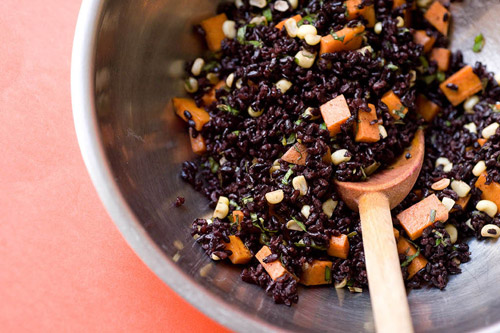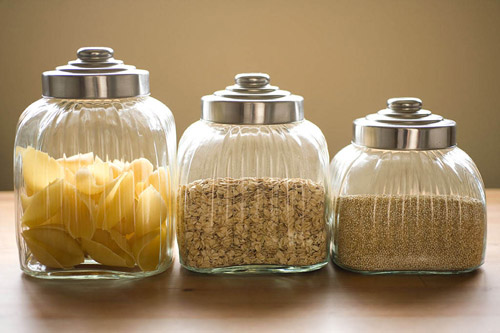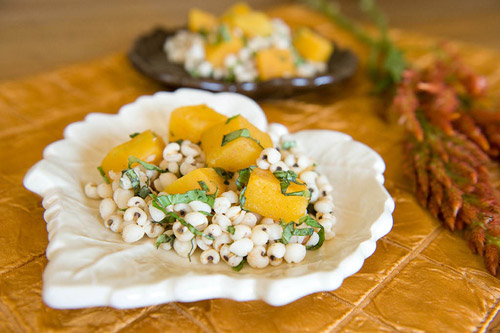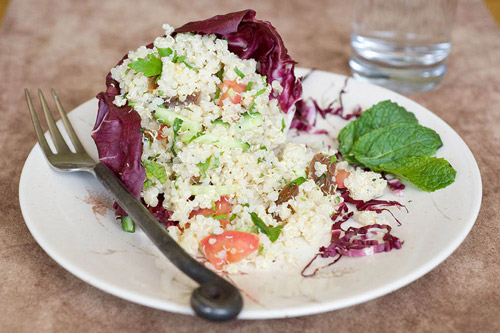Blissful Bites (31 page)

This is a healthy plant-based take on salads you may have had at a salad bar or at potlucks. It is easy to make and will be a crowd-pleaser at get-togethers. It's also a great way to use leftover beans. If you throw in some cooked quinoa, it makes a one-pot meal perfect to take to work for lunch.
1 large crown broccoli, cut into florets
1 large carrot, grated
1 cup cooked chickpeas, or 1 can (15 ounces), drained and rinsed
2 red radishes, thinly sliced
creamy mustard dressing
1
â
2
cup vegan mayonnaise
2 tablespoons Dijon mustard
1 tablespoon maple syrup
1 tablespoon sherry or apple cider vinegar
Pinch sea salt and black pepper
Steam the broccoli until crisp-tender, about two minutes. Remove from heat and toss with rest of salad ingredients. Whisk together dressing ingredients in small bowl. Toss with salad and chill for 10 minutes before serving. Great the next day!
“Health is a state of complete harmony of the body, mind, and spirit. When one is free from physical disabilities and mental distractions, the gates of the soul open.”
â B.K.S. Iyengar

not-so-forbidden rice salad
ââââââââ
A grain a day will keep the doctor away. Wait, that's not right, but it should be. We need whole grains in our lives! Grains can be stored for thousands of years, transported across many seas, and feed billions of people. They are close to the perfect food and have been eaten by traditional cultures for ages. Grains supply the complex carbohydrates that our bodies need for brain function, blood-sugar regulation, and metabolism stabilization, and they help keep our digestive tracts running smoothly, all while keeping us centeredâallowing us to connect to our bliss.
                       Â
simple lemon-scented basmati rice
                       Â
penne with creamy red pepper sauce
                       Â
                       Â
                       Â
Not all grains are created equal. There are whole grains, cracked grains, and grain products, and then there are refined grains from which you want to stay far away. The USDA daily recommendation for grains is three to five servings, with half of those being from
whole
grains. What they fail to mention is that most of the “whole” grains that we eat tend to not be whole at all. A whole grain has the bran, germ, and endosperm still intact. So bread or flour is not a whole grain. Not that you can't eat bread every once in a while, but most of your complex carbohydrates should be actual whole grains. Their health benefits are immense. Whole grains are excellent at sustaining blood sugar, supplying good fiber to keep everything running smoothly, giving you lasting energy, and lowering cholesterol, and are full of many beneficial vitamins and minerals. Below are some of my fave grains.
There are endless types of rice: brown rice is the staple grain and comes in short, medium, long, basmati, and jasmine. The first two are for daily use; the last three I tend to eat in warmer months because they are light and cook quickly. Then there are fancier rice varieties, such as black forbidden, Bhutanese red, Arborio, and wild rice. Use different kinds of rice to add variety to your cooking.
Quinoa is actually a seed, but it gets thrown in the whole grain section. It's probably my favorite grain next to Lundberg's “Golden Rose” medium brown rice. It has the highest amount of protein of all the grains and is one of your best sources of plant-based protein. So have your fill! It's great for warmer months because of its quick cooking time.
Millet is the most underappreciated of the grains and is usually associated with bird food. It is naturally sweet, making it great for the pancreas and those with blood sugar disorders. It's good all year round and is excellent in soups, for soft grain dishes, paired with sweet vegetables, or used as a base for burgers and croquettes.
Barley is one of those grains you either love or you don't. It is hearty, and its energy is known for being relaxing. It's great mixed with other grains and in soups. Be sure to get hulled barley, rather than pearled barley, which has been stripped of its fiber and minerals. My favorite barley-esque grain is
hato mugi
. It may be hard to find, and can be quite expensive since it comes from East Asia, but once you try it, you will know why it's my favorite. The taste and texture is unlike any other grain I've tried.

Yes, corn is a grain! It's naturally sweet and delicious. It's been getting a bad rap lately since it's one of the highest GMO crops and is used to make nasty products like high fructose corn syrup. If you can get it organic, local, and non-GMO, I think it's great to have in the summer when it's usually grown. The cracked grain
polenta
, or
corn grits
, is found in this cookbook, which is easier to digest than corn, and nourishing to the heart.
Rarely does anyone actually eat whole oats anymore. The oats you probably know are steel-cut or rolled oats. These are more of a cracked-grain than whole, but don't worry. You get some of the benefits that oats give; high in protein, minerals, vitamins, and cholesterol-lowering fiber.
I rarely eat buckwheat as a whole grain, but I love eating soba noodles as an alternative that adds variety to my diet. Noodles are grain products, and I eat them on occasion. Using buckwheat flour adds a new dimension to baked goods.
We all know what wheat is, but most of our wheat comes in the form of flour, bread, crackers, cereals, and seitan. Ideally, if you are eating these grain products, make sure they are made with whole wheat and whole grains, rather than enriched or refined grains. If you have a gluten intolerance, you can try the many gluten-free breads that are now available at any natural food store. Wheat berries, the actual whole-wheat grain, is hearty and mixes well with brown rice.
Spelt is becoming a popular grain to use as flour in breads and desserts. It's naturally wheat-free but does have gluten in it.
These are the tiniest grains. They make the perfect breakfast porridge, and they mix well with other grains. They are high in calcium and protein, and have a rich, nutty flavor.
Whole-grain pastas are great to have on occasion or when you need to make something quickly. I really love brown rice and quinoa pasta, which are both gluten-free and available at any natural food store. Couscous and bulgur are also grain products that require very little preparation time. These are not whole grains, so you want to eat them sparingly and not as your sole source of complex carbohydrates.
to soak or not to soak
Like most things in the cooking world, there are differing opinions on whether soaking grains is good or unnecessary. One thing you must always do is wash the grains. In my opinion, some grains do need to be soaked for better digestion and taste. Three to six hours is fine, or overnight. Short- and medium-grain brown rice, barley, and whole oats do best with soaking.
With most grains, I use a pinch of salt. Everyone's pinch is different, so grab a few grains of salt between your thumb and your forefinger. Don't go crazy with the salt. It's one pinch per cup of grain. If I'm pressure-cooking brown rice, instead of salt I like to use kombu (a sea vegetable explained on page 166).
For added variety and flavor, try experimenting with different grain combinations in the same pot. If they have a fairly similar cooking time, they can be combined. I usually stick with two grains at the most, and you can do 80/20, 60/40, or 50/50. It's delicious to add other things to your grains, like chestnuts or other nuts, beans, or root veggies, so get creative with those grain dishes!
Some grains, particularly millet, taste magnificent when dry-roasted in a skillet before cooking. To see how this is done, see the
asian quinoa and millet pilaf
recipe, on page 149.

barley “hato mugi” pilaf
barley “hato mugi” pilaf
![]()
![]()
![]() ⢠Makes 4 to 6 servings
⢠Makes 4 to 6 servings
Hato mugi is my favorite grain, but it's very expensive and hard to find. Feel free to substitute barley for this recipe if you can't get a hold of hato mugi.
1 cup hato mugi
1
â
2
cup vegetable broth
2 cups butternut squash, peeled and cubed
Pinch sea salt
1 tablespoon coriander
Dash paprika
2 tablespoons mirin
6 big leaves fresh basil, chopped
Cook hato mugi according to package instructions. Meanwhile, heat broth in a medium skillet with butternut squash and pinch of sea salt. Cover and simmer for five minutes, stirring occasionally. Add spices and mirin, and simmer until squash is tender. If it begins to stick, add a touch more broth. When hato mugi is done, combine with squash and basil in a medium bowl. Serve warm or cold the next day.
![]()
![]() ⢠Makes 4 to 6 servings
⢠Makes 4 to 6 servings
This is a great salad for warmer weather and will make you feel like you're in Greece. Not that I've ever been to Greece, but I feel like I'm in sitting on an island overlooking the water when I have this salad.
1
1
â
2
cups Israeli couscous
1
â
4
cup filtered water for sautéing
6 sun-dried tomatoes (not in oil), soaked in hot water for 10 minutes, sliced
2 cups zucchini, cut in half-moons
1 cup fresh corn, off the cob
1 tablespoon tarragon
1 tablespoon thyme
2 tablespoons balsamic vinegar
2 tablespoons tamari
1 can (4 ounces) chopped olives, or
1
â
2
cup fresh chopped olives
1 teaspoon olive oil
1
â
2
cup cherry tomatoes, halved
Sea salt and black pepper, to taste
Cook couscous according to the package directions. Meanwhile, heat water in a medium skillet and water sauté zucchini and corn with the spices for a few minutes. Stir in vinegar, tamari, and olives and set aside. Toss couscous with olive oil, veggie mixture, and both sun-dried and cherry tomatoes. Let sit for 15 minutes to allow the flavors to meld. Season with sea salt and black pepper as needed. Great served cold.
![]()
![]()
![]() ⢠Makes 5 to 7 servings
⢠Makes 5 to 7 servings
This is not your usual pad thaiâ¦as the name states. I love pad thai, but I also really love Thai curry, so I came up with a sauce that is a fusion of my two favorite Thai dishes to create this. Don't try to compare it to the pad thai you've had in the past; just appreciate it for its uniqueness.
pad thai sauce
1
â
2
teaspoon red chili paste (or more for spiciness)
1
â
2
cup raw sliced almonds
1
â
4
cup fruit-sweetened apricot jam
2 tablespoons dulse
2 tablespoons tamari
1 lime, zested and juiced
1 teaspoon ginger, minced
2 tablespoons white miso
1
â
2
cup water
1 package (8 ounces) rice noodles
1 medium zucchini, half-moon
1 medium carrot, matchsticks
1 cup cilantro leaves
2 cups bean sprouts
1 cup cucumbers, matchsticks
1 lime, juiced, for garnish
Blend
pad thai sauce
ingredients in a food processor until well combined and no chunks remain. Meanwhile, cook rice noodles according to package and lightly steam zucchini and carrots. Toss veggies, noodles, and sauce in a medium bowl with cilantro, sprouts, and cucumbers. Let sit for 10 minutes to let flavors meld. Garnish with a dash of lime juice.
Â
blissful variation
If you want your sauce to be spicier feel free to add more chili paste.

quinoa tabouli
![]()
![]()
![]()
![]() ⢠Makes 6 to 8 servings
⢠Makes 6 to 8 servings
This recipe is a different take on traditional tabouli, usually made with bulgur wheat. Quinoa is the highest protein grain available, which makes it a better choice. This tabouli will be even better the next day!
